
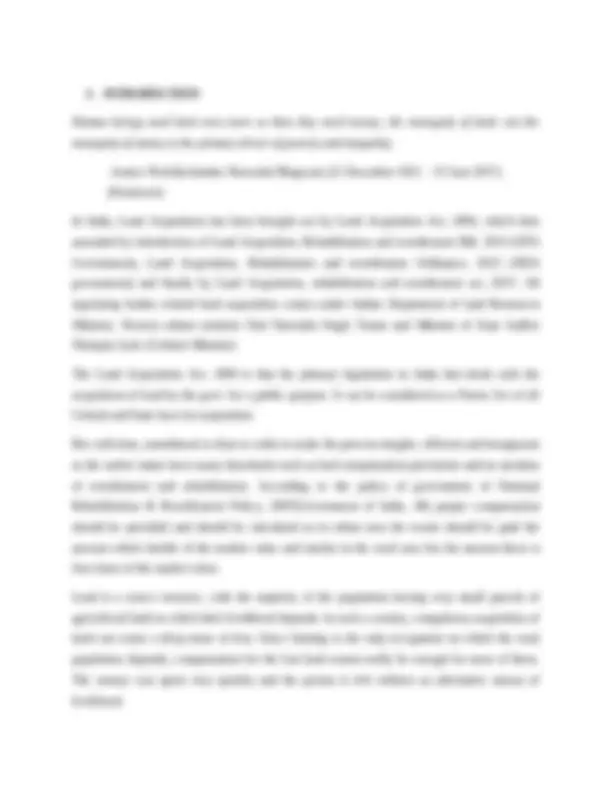
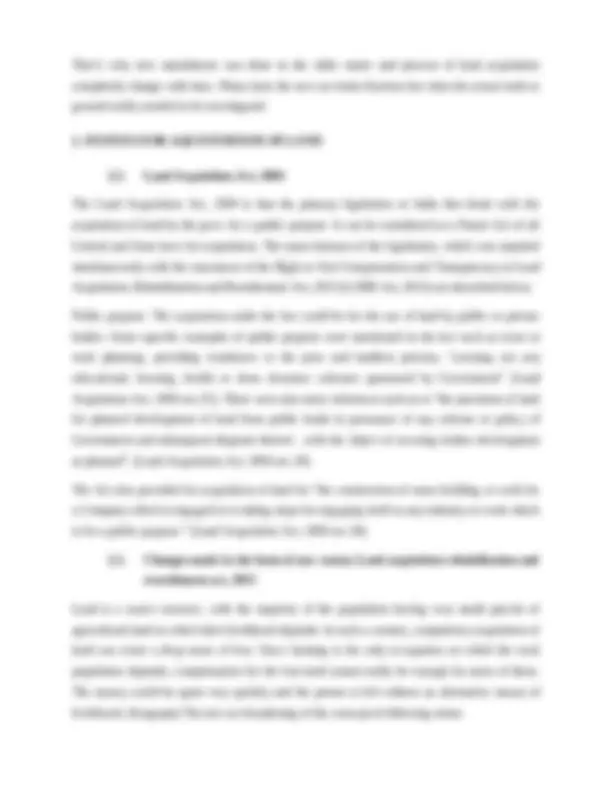

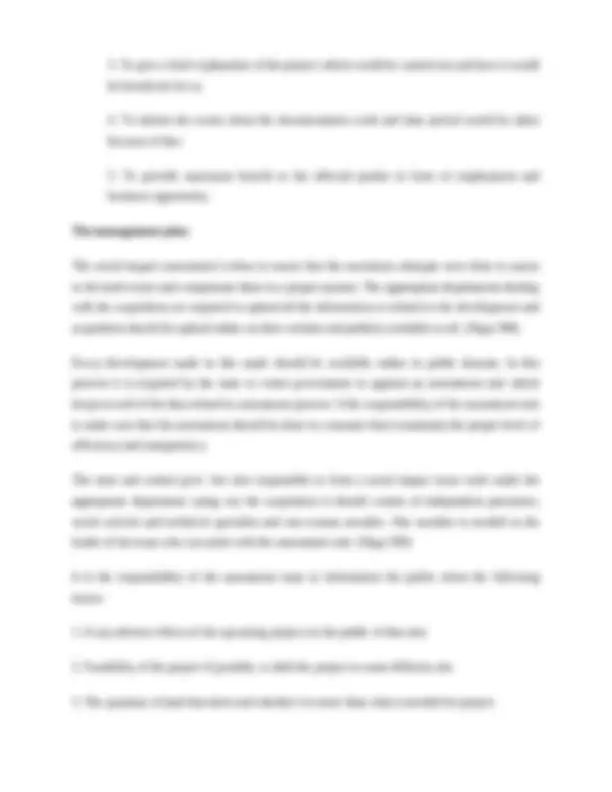
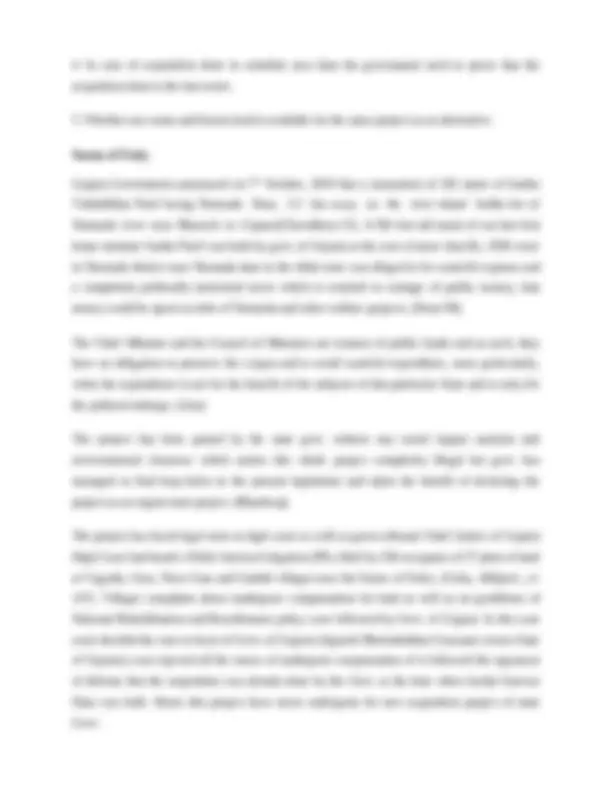
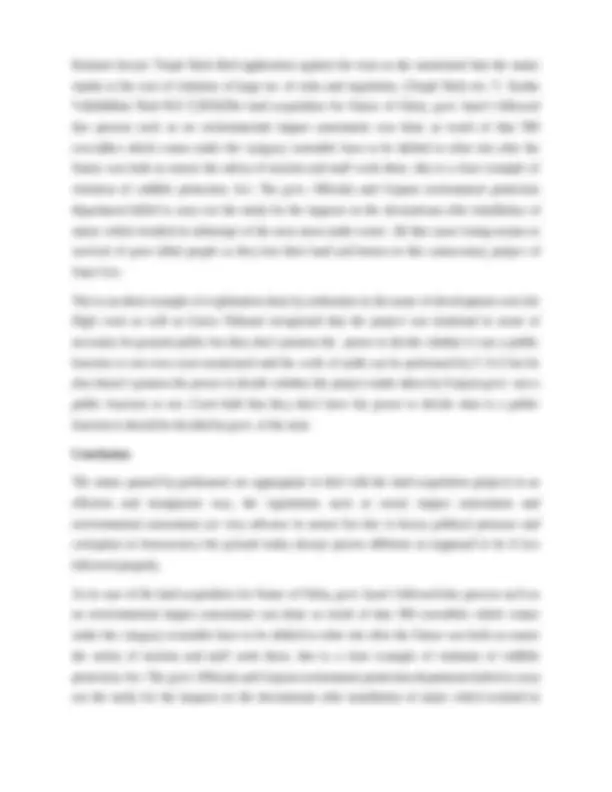
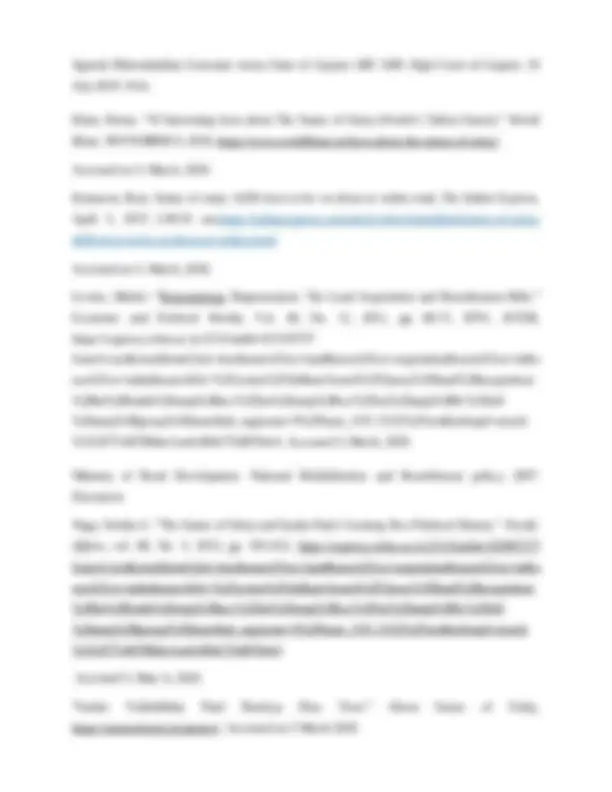

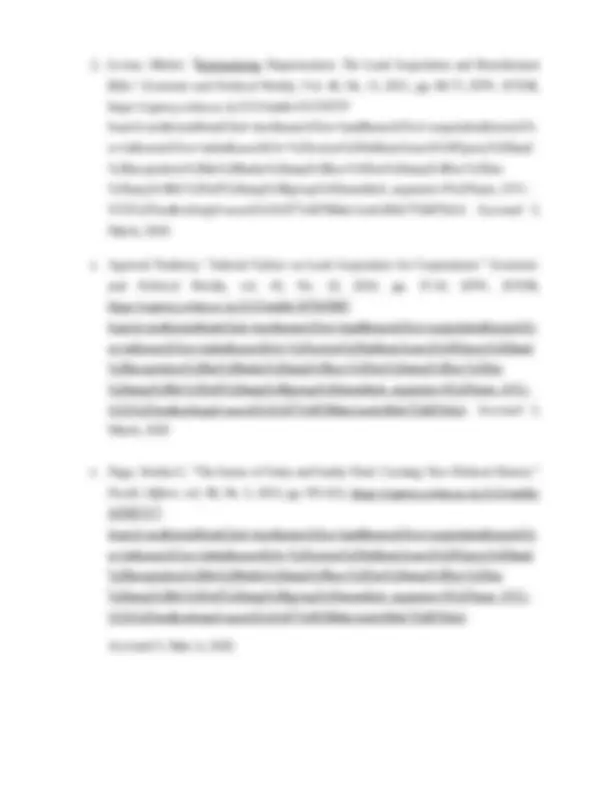



Study with the several resources on Docsity

Earn points by helping other students or get them with a premium plan


Prepare for your exams
Study with the several resources on Docsity

Earn points to download
Earn points by helping other students or get them with a premium plan
Community
Ask the community for help and clear up your study doubts
Discover the best universities in your country according to Docsity users
Free resources
Download our free guides on studying techniques, anxiety management strategies, and thesis advice from Docsity tutors
this is the project based on flaws in statue of unity
Typology: Essays (university)
1 / 18

This page cannot be seen from the preview
Don't miss anything!











A Research Project Submitted On Land Acquisition in India: A study of laws and policies related to acquisition of land by state with a special reference to the case of Statue of Unity IN COMPLIANCE TO THE PARTAIL FULFILLMENT OF THE MARKING SCHEME, FOR 2019-20 , IN THE SUBJECT OF Political Science (Indian Administration) SUBMITTED TO: - SUBMITTED BY:- Mr. Ravi Saxena Gaurav_Chahar Faculty of Political Science Roll.no. A NMIMS UNIVERSITY BA LLB (Hons.) Mumbai ( Second Year) Received by………………. On date ……………. Time…….. On date ……………... Time…….
Abstract On various instances supreme court have mentioned that Article 19(f) (Constitution of India, 1949 Art. 19(f)) and article 31(Constitution of India, 1949 Art. 31) of Indian constitution many times acts as a deterrence to the development projects of state and central Govts. As the process of acquisition is very important for the development of country as it is fundament requirement of infrastructural in cases where land acquisition done by govt. which is necessary for ‘any public purpose’ (Sathe 219) it is in other terms actually a restriction on legal right to property of an individual citizen. India is 2nd^ largest in term of population with 1/7 of world population as its residents and in such a case the land resource has a great importance. (Khan) The primary occupation of our country is still farming which is completed based on land. In such situation if govt. requires land for development projects it is very obvious that it would certainly face some sort of opposition from dissenting land owners to cope up with this problem and to establish a very transparent and effective system for acquisition many amendments were done continuously in the older legislation. But still there are many lacunae in the present system as the ground reality is very different from land acquisition policies of govt., In this paper the researcher has tried to study the procedure followed by appropriate authorities and identify some of the negligent actions (if any) on part of Govt. of Gujarat in the construction of Statue of Unity and how it affected the resident tribal population. Keywords: Land Acquisition Act, 2013. The National Rehabilitation and Resettlement Policy, 2007, Statue of Unity, Indian wildlife Act, 1972, Shoolpaneshwar Wildlife Santuary, Kevadia.
That’s why new amendment was done in the older statue and process of land acquisition completely change with time. Prima facie the new act looks flawless but what the actual truth or ground reality needed to be investigated.
2. STATUES FOR AQCUITISITION OF LAND 2.1. Land Acquisition Act, 1894 The Land Acquisition Act, 1894 is that the primary legislation in India that deals with the acquisition of land by the govt. for a public purpose. It can be considered as a Parent Act of all Central and State laws for acquisition. The main features of the legislation, which was repealed simultaneously with the enactment of the Right to Fair Compensation and Transparency in Land Acquisition, Rehabilitation and Resettlement Act, 2013 (LARR Act, 2013) are described below. Public purpose: The acquisition under the law could be for the use of land by public or private bodies. Some specific examples of public purpose were mentioned in the law such as town or rural planning, providing residences to the poor and landless persons, “carrying out any educational, housing, health or slum clearance schemes sponsored by Government” (Land Acquisition Act, 1894 sec.25). There were also more references such as to “the provision of land for planned development of land from public funds in pursuance of any scheme or policy of Government and subsequent disposal thereof…with the object of securing further development as planned”. (Land Acquisition Act, 1894 sec.29) The Act also provided for acquisition of land for “the construction of some building or work for a Company which is engaged or is taking steps for engaging itself in any industry or work which is for a public purpose.” (Land Acquisition Act, 1894 sec.28) 2.1. Changes made in the form of new statue, Land acquisition rehabilitation and resettlement act, 2015 Land is a scarce resource, with the majority of the population having very small parcels of agricultural land on which their livelihood depends. In such a country, compulsory acquisition of land can create a deep sense of fear. Since farming is the only occupation on which the rural population depends, compensation for the lost land cannot really be enough for most of them. The money could be spent very quickly and the person is left without an alternative means of livelihood. (Sengupta) The new act broadening of the concept of following terms:
1.“interested persons”: Persons having interest in the land include not only those having title of the land but also persons with easement and tenancy rights, including sharecroppers and any person whose primary source of livelihood is likely to be adversely affected. (Government of India, 48)
Eminent lawyer Trupti Shah filed application against the trust as she mentioned that the statue stands at the cost of violation of large no. of rules and regulation. (Trupti Shah ors. V. Sardar Vallabhbhai Patel R.E.T,2019)The land acquisition for Statue of Unity, govt. hasn’t followed due process such as no environmental impact assessment was done as result of that 500 crocodiles which comes under the category venerable have to be shifted to other site after the Statue was built as ensure the safety of tourists and staff work there, this is a clear example of violation of wildlife protection Act. The govt. Officials and Gujarat environment protection department failed to carry out the study for the impacts on the downstream after installation of statue which resulted in submerge of the near areas under water. All this cause losing means to survival of poor tribal people as they lost their land and homes in this unnecessary project of State Gov. This is an ideal example of exploitation done by authorities in the name of development even the High court as well as Green Tribunal recognized that the project was irrational in sense of necessity for general public but they don’t possess the power to decide whether it was a public function or not even court mentioned said the work of audit can be performed by C.A.G but he also doesn’t possess the power to decide whether the project under taken by Gujarat govt. was a public function or not. Court held that they don’t have the power to decide what is a public function it should be decided by govt. of the state. Conclusion The statue passed by parliament are appropriate to deal with the land acquisition projects in an efficient and transparent way, the regulations such as social impact assessment and environmental assessment are very advance in nature but due to heavy political pressure and corruption in bureaucracy the ground realty always proves different as supposed to be if law followed properly. As in case of the land acquisition for Statue of Unity, govt. hasn’t followed due process such as no environmental impact assessment was done as result of that 500 crocodiles which comes under the category venerable have to be shifted to other site after the Statue was built as ensure the safety of tourists and staff work there, this is a clear example of violation of wildlife protection Act. The govt. Officials and Gujarat environment protection department failed to carry out the study for the impacts on the downstream after installation of statue which resulted in
submerge of the near areas under water. All this cause losing means to survival of poor tribal people as they lost their land and homes in this unnecessary project of State Gov. This is an ideal example of exploitation done by authorities in the name of development even the High court as well as Green Tribunal recognized that the project was irrational in sense of necessity for general public but they don’t possess the power to decide whether it was a public function or not even court mentioned said the work of audit can be performed by C.A.G but he also doesn’t possess the power to decide whether the project under taken by Gujarat govt. was a public function or not. Gov. have clearly escaped in these cases using the shield of ‘clause public function’ and ‘urgency project’, the researcher hopes supreme court may take some action on this matter and set some form of guideline which sets a check on these urgency clauses. References Agarwal Pradeeep. “Judicial Failure on Land Acquisition for Corporations.” Economic and Political Weekly , vol. 45, No. 32, 2010, pp. 37-42. EPW, JSTOR, https://ezproxy.svkm.ac.in:2113/stable/20764386? Search=yes&resultItemClick=true&searchText=land&searchText=acquisition&searchText=in&s earchText=india&searchUri=%2Faction%2FdoBasicSearch%3FQuery%3Dland%2Bacquisition %2Bin%2Bindia%26amp%3Bacc%3Don%26amp%3Bwc%3Don%26amp%3Bfc%3Doff %26amp%3Bgroup%3Dnone&ab_segments=0%2Fbasic_SYC-5152%2Ftest&refreqid=search %3A3f77e46788dee1ea4c864e755d07b4c4. Accessed 5, March, 2020 Bhardwaj, Tarun. “Statue of Unity continues to generate revenue and attract tourists; these many crore earned from lakhs of visitors in just three months.” Financial Express, February 12, 2019 10:24:40 PM, https://www.financialexpress.com/lifestyle/travel-tourism/statue-of-unity- continues-to-generate-revenue-and-attract-tourists-these-many-crore-earned-from-lakhs-of- visitors-in-just-three-months/1485573/. Accessed on 5, March, 2020. “Cabinet Minister.” Department of Land Resources, https://dolr.gov.in/. Accessed on 5 March
Jignesh Dhirendrabhai Goswami versus State of Gujarat AIR 1369. High Court of Gujarat. 19 July 2019. Web. Khan, Heena. “10 Interesting facts about The Statue of Unity (World’s Tallest Statue).” World Blaze , NOVEMBER 9, 2018, https://www.worldblaze.in/facts-about-the-statue-of-unity/. Accessed on 5, March, 2020 Kumawat, Ram. Statue of unity: 4,830 trees to be cut down to widen road, The Indian Express, April 5, 2015 2:46:01 am,https://indianexpress.com/article/cities/ahmedabad/statue-of-unity- 4830-trees-to-be-cut-down-to-widen-road/. Accessed on 5, March, 2020. Levien, Michel. “Rationalizing Dispossession: The Land Acquisition and Resettlement Bills.” Economic and Political Weekly , Vol. 46, No. 11, 2011, pp. 66-71, EPW, JSTOR, https://ezproxy.svkm.ac.in:2113/stable/41151973? Search=yes&resultItemClick=true&searchText=land&searchText=acquisition&searchText=in&s earchText=india&searchUri=%2Faction%2FdoBasicSearch%3FQuery%3Dland%2Bacquisition %2Bin%2Bindia%26amp%3Bacc%3Don%26amp%3Bwc%3Don%26amp%3Bfc%3Doff %26amp%3Bgroup%3Dnone&ab_segments=0%2Fbasic_SYC-5152%2Ftest&refreqid=search %3A3f77e46788dee1ea4c864e755d07b4c4. Accessed 3, March, 2020. Ministry of Rural Development. National Rehabilitation and Resettlement policy, 2007. Document. Naga, Sirisha G. “The Statue of Unity and Sardar Patel: Creating New Political History.” Pacific Affairs , vol. 86, No. 3, 2013, pp. 591-612, https://ezproxy.svkm.ac.in:2113/stable/43590717? Search=yes&resultItemClick=true&searchText=land&searchText=acquisition&searchText=in&s earchText=india&searchUri=%2Faction%2FdoBasicSearch%3FQuery%3Dland%2Bacquisition %2Bin%2Bindia%26amp%3Bacc%3Don%26amp%3Bwc%3Don%26amp%3Bfc%3Doff %26amp%3Bgroup%3Dnone&ab_segments=0%2Fbasic_SYC-5152%2Ftest&refreqid=search %3A3f77e46788dee1ea4c864e755d07b4c4. Accessed 5, Marc h, 2020. “Sardar Vallabhbhai Patel Rastriya Ekta Trust.” About Statue of Unity, https://statueofunity.in/project/. Accessed on 5 March 2020
Sathe, Dhanmanjiri. The Political Economy of Land Acquisition in India: How a Village Stops being one. 13th^ ed., Pearson, 2016. Sengupta, Hindol. “Why India needs the Statue of Unity: No one recognized Vallabhbhai Patel’s contribution to the national movement on par — as it undoubtedly was — with Gandhi and Nehru” Telegraph India , 31, 10, 2018, 5: 50 P.M, https://www.telegraphindia.com/opinion/why- india-needs-the-statue-of-unity/cid/1673292. Accessed on 5, March, 2020. Trupti Shah ors. V. Sardar Vallabhbhai Patel R.E.T. J(Application No. 32/2015 & M.A.No.) National Green Tribunal, 2019 Vyas, Aditi, et al. “Comparative Evaluation of Land Acquisition and Compensation Processes across the World.” Economic and Political Weekly , vol. 46, No. 32, 2011, pp. 94-102, EPW, JSTOR, https://ezproxy.svkm.ac.in:2113/stable/23017763? Search=yes&resultItemClick=true&searchText=land&searchText=acquisition&searchText=in&s earchText=india&searchUri=%2Faction%2FdoBasicSearch%3FQuery%3Dland%2Bacquisition %2Bin%2Bindia%26amp%3Bacc%3Don%26amp%3Bwc%3Don%26amp%3Bfc%3Doff %26amp%3Bgroup%3Dnone&ab_segments=0%2Fbasic_SYC-5152%2Ftest&refreqid=search %3A3f77e46788dee1ea4c864e755d07b4c4. Accessed 5, March, 2020. Bibliography
Accessed on 5, March, 2020.